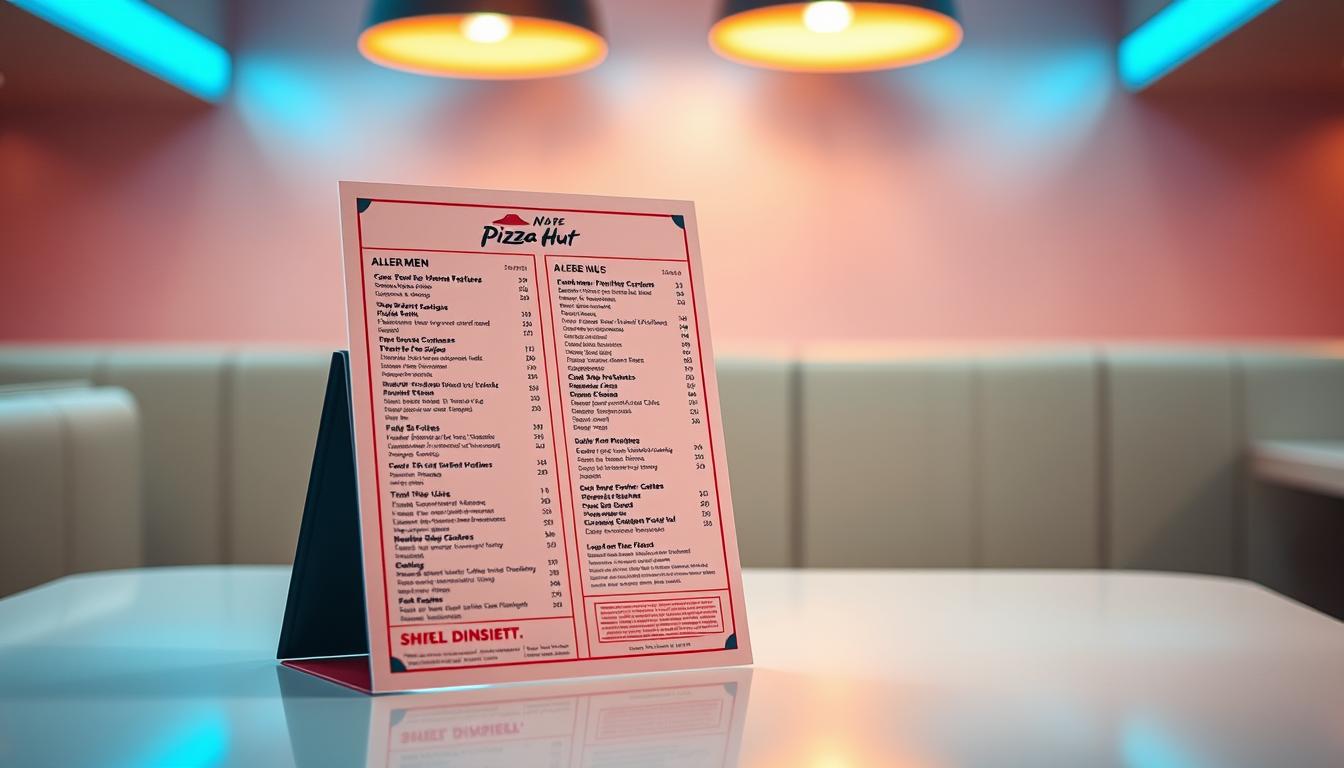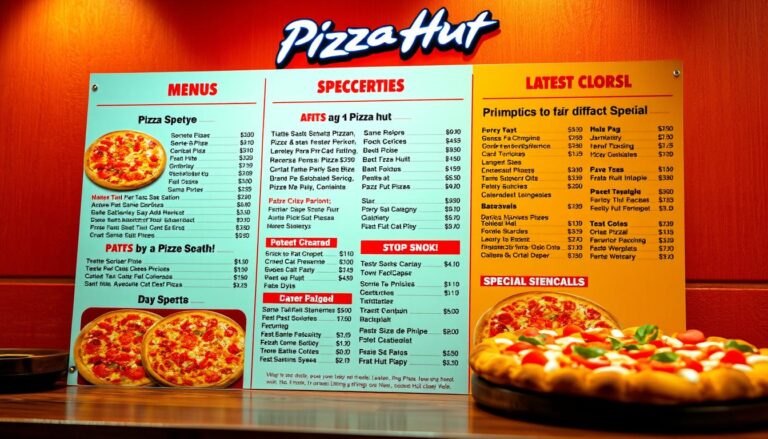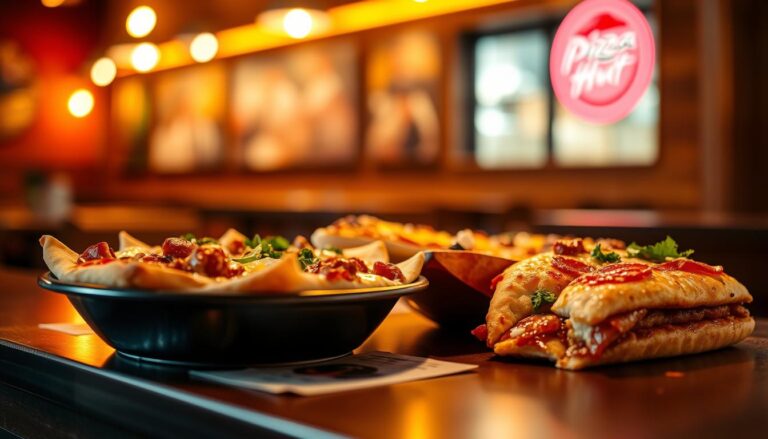Pizza Hut Allergen Menu – Safe Dining for Everyone
Pizza Hut has a clear menu for those with dietary restrictions. They offer online resources like an allergen chart and ingredient spreadsheets. These tools list common allergens item by item.
These documents are updated regularly. This ensures they reflect the latest allergy information.
This guide helps you find official disclosures and use the allergen chart. It also reminds you to confirm details when ordering. Pizza Hut can’t guarantee no cross-contact, even with gluten-free crust.
It’s important to inform staff about allergies at each visit. For serious allergies, always consult a healthcare provider.
Understanding Pizza Hut allergen labeling and chart
Clear allergen labeling lets diners make safe choices. The Pizza Hut allergen chart lists ingredients for pizzas, bases, toppings, sides, dips, WingStreet items, desserts, and drinks. It updates regularly to reflect recipe or supplier changes. Use the chart with your specific dietary needs in mind and confirm details when ordering.
What the allergen chart covers
The chart shows itemized listings across menu categories. It marks common allergen sources. Columns note cereals containing gluten/wheat, milk, soy, egg, fish, crustacean shellfish, mollusc, sulphur dioxide, sesame, celery, mustard, lupin, peanuts, and tree nuts. Supplier notes and manufacturing site details are included when relevant.
Allergen information is presented so you can compare pizzas, sides, and desserts at a glance. The document combines on-site product data with supplier declarations to give you complete pizza hut allergy information.
How to read Yes, No, C, and May contain indicators
‘Yes’ means the allergen is present and the product is not suitable for those with that allergy. ‘N’ or ‘No’ indicates the allergen is not an ingredient in the recipe, yet cross-contact risk may exist in the kitchen. ‘C’ flags that the allergen is present at the manufacturing site or there is a known cross-contact risk from the supplier. ‘May contain’ signals possible contamination in the supply chain or production line.
Customers should treat ‘No’ entries with caution when they have severe allergies. Staff notification remains essential every visit to reduce risk and get the latest pizza hut allergy information.
Which allergens are highlighted (FDA major allergens)
The chart emphasizes FDA major allergens: milk (dairy), wheat (gluten), soy, egg, fish, crustacean shellfish, tree nuts, and peanuts. It also highlights other declared risks such as sesame, celery, mustard, and sulphur dioxide.
| Allergen | Common sources on menu | Typical indicator | Customer note |
|---|---|---|---|
| Milk (dairy) | Mozzarella, cheese sides, desserts | Yes / May contain | Ask about cheese-free options and cross-contact |
| Wheat (gluten) | Crusts, bases, breaded items | Yes / C | Gluten-free crust availability varies by location |
| Soy | Sauces, some dough conditioners | Yes / May contain | Check refined oil sources with staff |
| Egg | Dressings, some baked items | Yes / N | Confirm for baked desserts and specialty items |
| Fish & Shellfish | Anchovies, specialty toppings | Yes / C | Seafood items often carry strong cross-contact warnings |
| Peanuts & Tree Nuts | Some dessert ingredients, supplier notes | May contain / C | Peanuts not used in-store, risk may come from suppliers |
| Sesame, Celery, Mustard, Sulphites | Spices, sauces, preserved ingredients | May contain / C | These are tracked because they affect sensitive diners |
Use the pizza hut allergen chart as a planning tool for dining out. For severe allergies, pair chart review with clear staff communication to address pizza hut dietary restrictions and reduce cross-contact risks.
pizza hut allergen menu
Looking for the pizza hut allergen menu? Check Pizza Hut’s official order site and contact pages. They have ingredient spreadsheets, PDFs, and product sheets with dates. This helps you know when the information was updated.
Most restaurants have printed ingredient guides. Staff can tell you about ingredients and any changes. But, always tell them about your allergies every time you visit.
Mobile and online ordering have nutrition and allergen pages. You can see the pizza hut allergen chart by product. Updates happen when suppliers or recipes change, so check often before ordering.
The charts are based on what suppliers say. But, things like regional differences and manufacturing changes can affect what you get. Pizza Hut can’t promise no cross-contact, which is key for severe allergy sufferers.
- Where to find files: order site PDFs and downloadable spreadsheets with valid-from dates
- In-store access: printed guides and staff confirmation for immediate questions
- Mobile app: real-time nutrition and allergen lookups before checkout
- Reliability note: based on supplier data; cross-contact risk remains
| Access Point | What to Expect | How It Helps | Best Use |
|---|---|---|---|
| Official website PDFs | Complete spreadsheets, valid-from dates, product specs | Reference for ingredient lists and allergen flags | Download before planning orders or gatherings |
| Online order platform | Searchable allergen chart by menu item | Quick checks while building an order | Use during checkout to confirm safe choices |
| Mobile app | Updated nutrition and allergen info, supplier changes noted | On-the-go access for last-minute decisions | Check before placing pickup or delivery orders |
| In-store printed guides | Physical ingredient lists and staff support | Immediate answers and staff verification | Ask staff when dining in or ordering in-person |
Common allergens in Pizza Hut ingredients
When you have allergies, it’s important to check the ingredients before you order. Pizza Hut has a menu and information about allergies. This helps you know what to avoid.
Gluten and wheat are common in dough and crusts. Breaded chicken and some sides also have wheat. Some sauces might have barley or wheat too. If you’re looking for gluten-free options, check the charts and talk to the staff.
Dairy is found in mozzarella and cheesy sides. Desserts and ice cream often have milk. WingStreet items and dips might have milk solids. Pizza Hut’s allergy information helps those with dairy allergies.
Eggs are in mayonnaise and some baked goods. They can also get on food from shared fryers. Soy is in soybean oil and soy sauce. If you’re allergic to soy, ask the staff about it.
Celery is in spice blends and sauces. Mustard is in coleslaw and dressings. Sesame might be a risk, and sulphur dioxide could be present in some ingredients.
Tree nuts and peanuts are not in most Pizza Hut menu items in the U.S. But, there might be “may contain” warnings. Always check the menu and tell the staff about any nut allergies.
Use the allergy information to understand risks. If you have a severe allergy, be careful. Ask the staff to note your allergy and avoid risky items.
| Item group | Common allergens | Typical sources listed | Advice for diners |
|---|---|---|---|
| Pizza crusts & dough | Wheat/Gluten, Soy, Milk | Wheat flour, wheat gluten, soy lecithin, milk in stuffed crust | Check crust type; ask about Udi’s or gluten-free options at Pizza Hut and cross-contact |
| Cheese & cheese-stuffed items | Milk | Mozzarella, processed cheese, sodium caseinate | Avoid cheese items for milk allergy; confirm ingredient specifics |
| Breaded chicken & sides | Wheat, Egg, Milk, Soy | Breadings with wheat, egg wash, milk-based coatings, soybean oil | Avoid if severe allergy; ask about fryer use and coatings |
| Sauces & dressings | Soy, Wheat, Celery, Mustard, Sesame | Soy sauce, malt extract, spice blends, mustard seed, sesame traces | Request ingredient list and check pizza hut allergen menu for updates |
| Desserts & frozen treats | Milk, Egg, Wheat, Nuts (may contain) | Milk powder, egg in baked items, cookie dough with wheat; supplier may note nuts | Confirm supplier “may contain” warnings before ordering |
Gluten-free options at Pizza Hut and limitations
Pizza Hut has some gluten-free choices on its menu. They offer Udi’s® certified gluten-free crust at some places. But, it’s important to check the local menu before you order.
This section talks about what they offer and safety tips for those with gluten issues.
Udi’s certified gluten-free crust is available at some Pizza Hut places. It meets gluten-free standards. They also list some gluten-free ingredients that can be used with this crust.
But, Pizza Hut prepares food in shared spaces. This means there’s a risk of gluten cross-contact. Even with a certified crust, it’s not a safe place for everyone.
Everyone’s health needs are different. Pizza Hut doesn’t suggest Udi’s crust for those with celiac disease. If you have severe gluten sensitivity, talk to your doctor before eating here.
To lower the risk, tell the staff about your allergy. Ask if they can use separate areas or gloves. Always check the ingredient list and review the menu for updates.
| Topic | What to expect | Action for shoppers | Risk level |
|---|---|---|---|
| Udi’s certified gluten-free crust | Certified gluten-free crust available at select Pizza Hut locations | Confirm local availability before ordering | Medium (certified product, but shared kitchen) |
| Shared equipment and surfaces | Ovens, prep counters, utensils, and fryers are shared | Request extra precautions and separate prep when possible | High (cross-contact possible) |
| Menu and supplier changes | Ingredient lists and suppliers can change over time | Check the pizza hut allergen menu and pizza hut allergy-friendly menu at ordering | Variable (depends on current suppliers) |
| Recommendations for celiac disease | Company guidance advises caution; not recommended for strict celiac diners | Consult a healthcare provider before dining and consider alternatives | Very high for strict celiac adherence |
| On-the-spot precautions | Staff notification, fresh gloves, and separate utensils may be requested | Make requests when ordering and confirm staff can comply | Moderate, depending on staff practices |
Vegan pizza hut menu choices and vegan-friendly items
Looking for vegan options at Pizza Hut? The allergen menu and ingredient tables are your guides. They show which items are vegetarian or vegan. They also highlight cross-contact risks with flags like ‘C’ or ‘may contain’. This info helps plan meals that fit your dietary needs.
It’s important to know the difference between vegetarian and vegan. Many doughs and cheeses have milk or whey. This means some items are vegetarian but not vegan. Some toppings and sauces are vegan, but check for ‘may contain’ warnings.
Here are some vegan-friendly toppings and sides to help you choose wisely.
- Vegetable toppings: jalapeños, mixed peppers, mushrooms, pineapple, red onions, sliced black olives, sweetcorn, tomatoes.
- Sauces: some tomato-based sauces are vegan; BBQ and Sweet Chilli vary by recipe—verify each supplier entry.
- Sides: plain tortilla chips, basic salads without dairy dressings, and selected fruit sides may be vegan-friendly when dressings are avoided.
For strict vegans, be aware of cross-contact risks. Cheese, buttery margarine, and shared fryers can introduce dairy or egg traces. WingStreet frying often includes egg and milk in fried items.
To reduce risk, tell staff about your vegan needs. Ask for separate utensils and avoid items marked with ‘C’ or ‘may contain’. If unsure, ask for ingredient printouts or check the app for updates on dietary restrictions.
| Item | Description | Vegan-friendly? | Cross-contact note |
|---|---|---|---|
| Classic Tomato Sauce | Rich tomato base used on many pizzas | Yes (verify supplier) | May be prepared in shared pans |
| Grilled Mushrooms | Sliced mushrooms as a topping | Yes | Check for ‘may contain’ manufacturing notes |
| Sliced Black Olives | Pre-sliced olives for topping | Yes | Minimal risk, verify supplier flags |
| Sweetcorn | Sweetcorn kernels used on pizzas | Yes | Possible shared handling with non-vegan items |
| Plain Tortilla Chips | Snack side without cheese | Sometimes | Depends on seasoning; check label |
| Side Salad (no dressing) | Mixed greens and vegetables | Yes if no dairy or egg dressing | Request dressing on the side to avoid contact |
| BBQ Sauce | Sweet and smoky sauce | Varies by supplier | Verify specific allergen chart entry |
Remember, ingredients can change. Always check the allergen menu and talk to staff. This way, dining out is easier and safer for those who follow a plant-based diet.
Nut-free pizza hut choices and peanut/tree nut policies
Pizza Hut says they don’t use peanuts or tree nuts in their restaurants. But, ingredients might be handled in places where nuts are present. This means some products might have “may contain” warnings.
If you’re looking for nut-free options, check the pizza hut allergen menu first. The menu clearly labels items as safe, conditional, or “may contain” based on supplier statements.
Here are some tips to help you make safer choices at Pizza Hut:
Policy overview
Pizza Hut doesn’t use peanuts or tree nuts in their recipes. But, suppliers might handle nuts at their facilities. That’s why some products have “may contain” warnings on the pizza hut allergen menu.
Typical nut-free options and caution areas
Most plain pizza bases, meat toppings, and veggies don’t have nuts. Also, simple sides like fries and salads usually don’t have nuts.
But, desserts and some toppings might have “may contain” warnings. This includes cookie dough and ice cream, which could have tree nuts.
Best practices for nut-allergic diners
- Tell staff about your nut allergy every time you visit and ask for extra care.
- Always check the pizza hut allergen menu and product specs for “may contain” warnings before ordering.
- Stay away from desserts and items with “may contain” tree nut warnings if you’re very cautious.
- Opt for simple items like a plain crust with safe toppings. Ask staff to change gloves or use clean utensils.
- If you’re unsure, call Pizza Hut customer service or the store to get the latest allergy information before ordering.
The table below lists common choices, their nut risk, and quick advice for those seeking nut-free options at Pizza Hut.
| Items | Description | Nut Risk | Recommended Action |
|---|---|---|---|
| Plain Pan or Hand-Tossed Crust | Classic crust used for most pizzas without specialty sauces or toppings | Low (no nut ingredients listed) | Order plain with safe toppings; inform staff of allergy |
| Vegetable Toppings (peppers, onions, mushrooms) | Fresh or prepared vegetables used as pizza toppers | Low (ingredient lists show no nuts) | Confirm handling practices; request fresh utensils |
| Meat Toppings (pepperoni, sausage, chicken) | Cured and cooked meats supplied by third parties | Low to Medium (some processed meats may have supplier notes) | Check pizza hut allergen menu for “may contain” statements |
| Garlic Bread and Some Sides | Prepared bakery-style sides and sauces | Medium (some items carry “may contain” warnings) | Avoid if strict allergy; confirm supplier notes |
| Desserts (cookie dough, ice cream) | Packaged desserts often made in shared facilities | High (frequent “may contain” tree nut warnings) | Do not order if any risk is unacceptable |
| Salads (simple greens) | Fresh salads without added nuts or dressings | Low to Medium (dressings may be processed) | Ask for dressing on the side and verify ingredients |
| Dipping Sauces | Packaged or prepared sauces served with sides and pizzas | Medium (some sauces include supplier warnings) | Check the pizza hut allergen menu and avoid flagged sauces |
Cross-contamination policy and kitchen practices at Pizza Hut
Pizza Hut makes it easy for diners to choose wisely. They provide detailed information on their allergen menu and allergy info. This helps guests understand the risks related to ingredients, suppliers, and how food is prepared. It’s important to read these resources before ordering, and to be extra careful if you have severe allergies.
Shared equipment, frying process, and hot-holding risks
Many items at Pizza Hut are made in shared areas. This includes cutters, utensils, prep surfaces, and hot-holding wells. This setup increases the risk of cross-contamination with wheat, milk, egg, and soy.
Frying items like WingStreet wings and chips can introduce allergens into the batter and oil. It’s hard to fully separate these items in shared fryers and baskets. Also, hot-holding and warming stations can spread crumbs and sauces between trays.
Role of staff notification and asking for extra precautions
Customers must inform staff about their allergies each time they visit. This way, staff can take steps to prevent cross-contamination. They might use separate utensils, change gloves, or prepare items in a cleaner area.
Pizza Hut staff follow strict guidelines and training to minimize cross-contact. The brand can’t guarantee that a product is completely free from allergens. So, people with severe allergies should think carefully before ordering.
Supplier “may contain” statements and manufacturing site cautions
Ingredients often have ‘C’ or ‘may contain’ labels if there’s a risk of contamination. These labels are on the pizza hut allergen menu and in allergy information, even if the allergen isn’t listed as an ingredient.
Recipes and suppliers can change, and Pizza Hut updates its allergen charts when this happens. Customers should always check the latest pizza hut allergen menu and contact the restaurant for the most current information before ordering.
| Risk Area | Common Allergens Involved | Staff Actions | Customer Action |
|---|---|---|---|
| Shared prep stations | Wheat, milk, soy | Sanitize surfaces, use clean utensils | Inform staff at ordering |
| Fryers and oil | Wheat, egg, milk | Avoid cross-use, label baskets | Request alternatives off fried menu |
| Hot-holding wells | Crumbs, sauce residues | Rotate pans, wipe wells | Ask for fresh-made items |
| Supplier manufacturing | Nuts, sesame, soy | Track supplier notes, flag items | Check pizza hut allergen menu online |
Pizza Hut allergen chart examples from menu items
Looking at sample entries can help diners spot risks on the pizza hut allergen chart. Below are concise examples for bases, toppings, and sides with the typical allergen flags seen on the pizza hut allergen menu. Use these examples as guides when checking pizza hut allergy information for specific locations or recipe updates.
Pizza bases often list wheat and milk among primary ingredients. Standard dough usually contains wheat flour, wheat gluten, yeast, milk whey, and emulsifiers such as mono- and diglycerides. Enzymes and flour treatment agents can add hidden traces. Some alternative prebakes or corn-based crusts may show “may contain” gluten on supplier notes.
| Item | Description | Key Allergens | Typical Flags |
|---|---|---|---|
| Standard Dough Base | Wheat flour, wheat gluten, yeast, milk whey, emulsifiers, enzymes | Wheat, Milk, Soy (lecithin) | Yes (Wheat), Yes (Milk), C (Soy) |
| Gluten-Reduced/Alternate Crust | Cornmeal/polenta premix or specialty premix | May contain Gluten, Corn | May contain (Gluten), No (Milk) |
| Pepperoni | Seasoned cured pork/some suppliers include soy protein | Pork, Soy, Possible Tree Nut cross-contact | C (Soy), May contain (Tree Nuts) |
| Chicken Topping (Breaded) | Breaded fried chicken, batter with egg and milk | Egg, Milk, Wheat | Yes (Egg), Yes (Milk), Yes (Wheat) |
| Anchovies / Tuna | Canned or preserved fish toppings | Fish | Yes (Fish), N (Crustaceans) |
| Potato Wedges | Potato, sunflower oil, wheat flour in coating, spice blends | Wheat, Possible Egg, Milk, Celery | Yes (Wheat), May contain (Egg, Milk, Celery) |
| Garlic Bread | Wheat bread, margarine (may contain milk traces), garlic seasoning | Wheat, Milk, Soy, Peanuts (supplier notes) | Yes (Wheat), May contain (Milk, Soy, Peanuts) |
| Cookie Dough Dessert | Cookie dough, chocolate, cake or cream bases | Milk, Egg, Gluten, Tree Nuts (may contain) | Yes (Milk), Yes (Egg), Yes (Gluten), May contain (Tree Nuts) |
Supplier declarations often mark “may contain” items where cross-contact is possible in manufacturing. The pizza hut allergen chart and pizza hut allergen menu reflect these supplier notes. Many desserts carry multiple flags for milk, egg, gluten, and tree nuts due to ingredients and shared equipment.
When reviewing pizza hut allergy information, note that frying, breading, and shared prep stations increase cross-contact risk. Use the chart as a starting point and confirm with staff or the official PDF for the latest supplier changes.
How to order safely: tips for customers with dietary restrictions
Guests with allergies or special diets should plan their Pizza Hut visits carefully. Make clear, simple requests and confirm details before ordering. Choose items with fewer ingredients to lower cross-contact risk.
Always tell staff about your allergy every visit. Mention the allergen by name and ask them to note your order. They can check the current pizza hut allergen menu and alert the kitchen for extra care.
Ask about ingredient substitutions and check for supplier changes. Ingredients and recipes can change over time. Confirm that the chosen item matches the pizza hut allergy information available online or in the store at the moment of ordering.
When to consult a healthcare provider: some items contain refined oils such as soybean oil. Many people with soy allergy tolerate fully refined soybean oil, yet doctors and allergists should advise patients with severe reactions. For those with Celiac disease, a medical professional can help assess the risks of eating in a non–gluten-free environment.
Practical ordering tips make meals safer. Pick simple items like plain cheese or single-topping pizzas with known ingredients. Avoid items labeled “may contain” or marked with a “C” on the allergen chart. Ask for separate preparation and separate utensils when feasible.
- Inform staff at pickup or delivery and repeat the allergy when the order is delivered.
- Confirm no ingredient substitutions and request plain packaging or separate containers for sides.
- Prefer in-store orders if you need to speak directly with crew about pizza hut dietary restrictions.
- Keep emergency medication accessible if there is a history of anaphylaxis.
| Action | Why it helps | Where to verify | Best practice |
|---|---|---|---|
| Tell staff about your allergy every visit | Triggers kitchen alert and extra care | Store crew, online pizza hut allergen menu | Repeat allergy at handoff and delivery |
| Check current ingredient lists | Suppliers and recipes can change | Updated pizza hut allergy information PDF | Confirm just before ordering |
| Choose simpler items | Fewer components mean fewer risks | Menu descriptions and allergen chart | Plain cheese or single-topping options |
| Avoid “may contain” or “C” items | Indicates possible cross-contact or conditional ingredient | Allergen chart entries and staff confirmation | Select alternatives without warnings |
| Consult healthcare provider for specific risks | Provides tailored medical advice for soy, oils, or celiac | Allergy specialist or primary care | Follow provider guidance before trying items |
| Request separate prep and packaging | Reduces chance of cross-contact | In-store crew or special instructions online | Ask for clean utensils and fresh gloves |
Use the pizza hut allergen menu and pizza hut allergy information as tools. Treat them as a starting point, not a guarantee. When pizza hut dietary restrictions affect your choice, consider gluten-free options at pizza hut only after consulting staff and your healthcare provider.
Contacting Pizza Hut for the latest allergy information
Customers with food sensitivities should reach out to confirm current ingredient and supplier details before ordering. Pizza Hut posts a digital pizza hut allergen menu and supporting PDFs for easy reference. For urgent questions about a local order, contact the specific restaurant listed in the app or on the ordering site.
Phone help is available for broader nutrition and allergy inquiries. Corporate materials list 1-800-948-8488 for nutrition and allergy support, and the online contact form on the order site routes questions to the right team. Use pizza hut contact options to request the latest pizza hut allergy information or to ask about a recent change in recipes.
Menu items, limited-time offers, and supplier ingredients can change. That is why checking the pizza hut allergen chart regularly matters for safety. Supplier “may contain” statements and manufacturing-site practices update over time, so reconfirm details when sensitivity is severe.
When calling or using the contact page, be specific about the product, location, and the allergen of concern. Clear requests help staff provide accurate pizza hut allergy information and point you to the most recent pizza hut allergen menu file for your region.
- Use the order site contact page for documented responses and PDF links.
- Call 1-800-948-8488 for corporate-level nutrition and allergy queries.
- Contact the participating restaurant for immediate, location-specific answers.
Keeping records of communications and checking the pizza hut allergen chart before every order helps protect those with serious allergies. Always verify changes to recipes, suppliers, and preparation methods to reduce risk and make informed choices.
Conclusion
Pizza Hut offers a detailed menu for those with allergies. They list common allergens like gluten, dairy, and nuts. This helps diners make safe choices, including vegan and vegetarian options.
Some Pizza Hut places have gluten-free crusts. But, it’s not completely allergen-free. Always check with staff about your allergies. You can also call Pizza Hut for more information.
For a safe dining experience, pick simple pizzas or veggie-topped ones. Always check the latest allergy information. If you’re unsure, talk to a doctor. This way, you can enjoy your meal safely.
FAQ
Where can I find Pizza Hut’s official allergen chart and ingredient specifications?
You can find Pizza Hut’s allergen spreadsheets and ingredient details on their website and online ordering platform. For more information, use the contact page on their order site (https://order.pizzahut.com/site/contact_us) or call 1-800-948-8488. Always check the document’s date and confirm the ingredients before ordering.
What does the allergen chart cover?
The chart lists allergens for pizzas, bases, toppings, sides, dips, WingStreet items, desserts, and drinks. It shows if items contain gluten, soy, egg, milk, fish, and more. It also notes if items are vegan or vegetarian.
How do I read the indicators like Yes, N, C and “may contain”?
“Yes” means the allergen is present and the product is not safe for those allergic. “N” (No) means the allergen isn’t an ingredient but there’s a cross-contact risk. “C” indicates the allergen is present at the supplier or manufacturing site. “May contain” is a supplier warning about possible contamination.
Which allergens are highlighted in Pizza Hut’s chart?
The chart focuses on FDA major allergens like milk, wheat, soy, egg, fish, and more. It also includes sesame, celery, mustard, and sulphur dioxide. Supplier tables often highlight allergens with bold flags.
Does Pizza Hut offer gluten-free options? Are they safe for people with Celiac disease?
Some locations offer Udi’s® certified gluten-free crust. But, Pizza Hut restaurants are not gluten-free. They have cross-contact risk. For Celiac disease or severe sensitivity, Pizza Hut advises against Udi’s crust. Always check with a healthcare provider before ordering.
Which menu items commonly contain gluten or wheat?
Many items like dough, crusts, and breaded chicken contain wheat/gluten. Some sauces also have wheat or barley. Always check the allergen chart and ingredient specs for details.
What are the primary dairy sources to watch for at Pizza Hut?
Mozzarella and processed cheeses are in many pizzas and sides. Sodium caseinate and milk powder are in WingStreet items. Many items list milk as an allergen.
What about eggs, soy, sesame, celery and mustard?
Eggs are in mayonnaise and dressings. Soy is in soybean oil, soy lecithin, and soy sauce. Sesame, celery, and mustard are flagged where present. Always verify the latest supplier table.
Are there vegan-friendly Pizza Hut options?
The ingredient tables show vegetarian and vegan options. Vegan-friendly toppings include jalapeños and mushrooms. Some sauces and sides may also be vegan. But, always check for cross-contact flags.
Are peanuts and tree nuts used in Pizza Hut restaurants?
Pizza Hut doesn’t use peanuts or tree nuts in preparation. But, supplier sites may handle them. Some items have “may contain” or “C” warnings. Desserts and processed toppings often have tree nut warnings.
How can someone with a nut allergy minimize risk when ordering?
Review the allergen chart for “may contain” and “C” flags. Choose simple items with fewer processed components. Avoid desserts or items flagged for nut risk. Inform staff of the nut allergy and request extra precautions. For severe allergies, contact Pizza Hut customer service before visiting.
How does cross-contamination happen in Pizza Hut kitchens?
Cross-contact can happen through shared tables, cutters, ovens, utensils, and frying oil. WingStreet frying and breading introduce wheat, egg, and milk into fried products. Pizza Hut warns that handcrafted preparation and shared equipment can’t guarantee no cross-contact.
What should I tell staff when I order with an allergy?
Tell staff about your allergy every time, specify the allergen(s), and ask them to check the current ingredient list. Request extra precautions like separate utensils. Staff will consult in-store guides, but can’t eliminate all risk. Always use the allergen chart as a starting point and confirm by phone or online if needed.
Do supplier “may contain” statements change over time?
Yes. Ingredient formulations, suppliers, and manufacturing-site practices change. Pizza Hut updates its digital allergen charts and PDFs when changes occur. Always check the most recent chart and confirm ingredients at time of order, for severe allergies.
How should people concerned about refined soybean oil proceed?
Fully refined soybean oil is used in some menu items and is often tolerated by many soy-allergic individuals. But, individual reactions vary. Consult a healthcare provider about tolerance to refined oils before consuming items with soybean oil or soy-derived emulsifiers.
When should I contact Pizza Hut directly about allergen questions?
Contact Pizza Hut before ordering if you have severe allergies, Celiac disease, or need confirmation beyond the online chart. Use the order site contact page or call 1-800-948-8488 for nutrition/allergy queries. For immediate, location-specific questions, call the participating restaurant directly and request the latest ingredient PDF via the mobile app or website.






